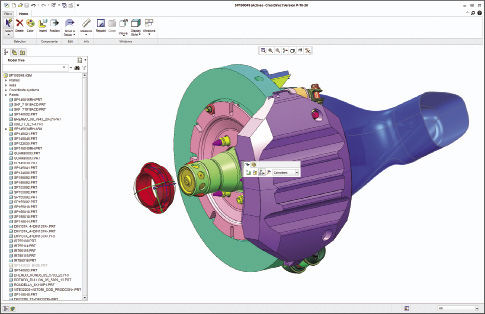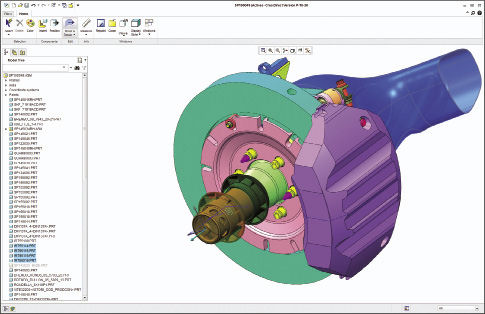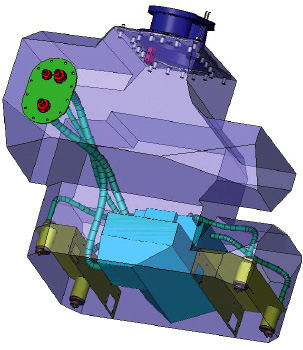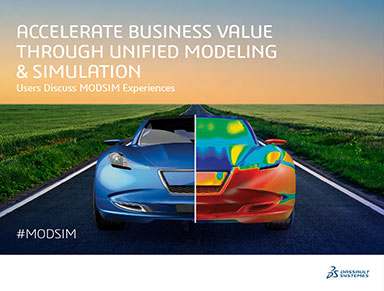The Best of Both Worlds
Automotive manufacturers have embraced an integrated workflow that incorporates elements of both direct and indirect 3D modeling.
Latest News
December 4, 2001
By Beth Stackpole
In the aftermath of the ongoing debate over whether direct modeling or history-based modeling is the preferred approach, the automotive industry has settled into an integrated workflow that incorporates the best of both 3D modeling paradigms for different design tasks.
 PTC’s Creo Direct facilitates direct editing on a brake disc diameter. Image courtesy of PTC. |
While history-based, or parametric modeling tools held court for the better part of two decades, a fresh crop of CAD programs burst onto the scene a few years ago, touting a more flexible and intuitive approach to 3D modeling. This prompted many to declare the end of an era for history-based CAD. But after the dust settled and as traditional history-based CAD vendors began to fold direct modeling functionality into their design suites, it became clear that both approaches have a place in the design workflow.
For example, while parametric CAD tools are best suited for creating the detailed geometries necessary for large model design, direct modeling tools can deliver a more efficient and flexible way to prepare models for simulation, perform early-stage concept work, or to collaborate on models in a multi-CAD environment.
“Two or three years ago, the discussion got very heated, but what’s happening now is there’s a realization that there is a need for both,” says Paul Sagar, director of product management, CAD segment for PTC. “It really comes down to what specific use case someone is trying to tackle, and what level of competency that user has. Today, we see companies deploying both direct and indirect modeling technologies in the same organization, letting users take advantage of whatever they want for their particular task.”
 Creo Direct is used to simultaneously change the length of the shaft and reposition the nut. Image courtesy of PTC. |
Proficiency with CAD systems and 3D modeling is also a factor in determining which 3D modeling paradigm fits best. “When you are using a parametric CAD system, you need a good understanding of how a parametric system works,” Sagar explains. “When you are using direct 3D CAD, you require potentially less knowledge.”
Making the ‘Use’ Case
In the automotive sector, there are a number of scenarios where direct modeling is the preferred approach. Consider the benefits of leveraging the technology for early-stage concept design: Automotive manufacturers, for example, are under constant pressure to explore a continuous stream of vehicle concepts to ensure they have the right innovation muscle to compete effectively on a global scale. According to Steve Hooper, director for automotive product development at Autodesk, direct editing capabilities allow automotive designers to come up with more concepts and weed out bad designs more quickly.
 KeyCreator’s direct editing capabilities let Aero Tec Laboratories’ engineers complete tasks at least 20% faster than traditional feature-based CAD. Image courtesy of Aero Tec Laboratories. |
“Instead of having to rebuild surfaces, direct modeling capabilities in a surface environment let engineers quickly build the next design iteration,” he explains. “It allows them to make subtle changes quickly to evaluate a broader range of concepts in a shorter amount of time.”
SpaceClaim, a pure play direct modeling program that sparked the debate several years back when it launched, has found a home within many automotive customers for just such early-stage design work, confirms Justin Hendrickson, SpaceClaim’s director of product management. “Direct modeling is not a solution that is going to serve the end-to-end needs of an automotive customer,” he admits. “But it can facilitate and speed the process in a number of individual groups within the organization.”
Hendrickson says many of SpaceClaim’s automotive customers prefer direct modelers over parametric 3D CAD programs when it comes time to leverage existing 3D models as a base for iterating new designs. “If you have a model with 500 features that you need to edit, it can be very cumbersome and slow to make changes with today’s history-based CAD tools,” he adds. “But with SpaceClaim or other direct modelers, you can just open the file of an engine block or drivetrain, slice off the one section you need, select a bunch of faces of geometry, and reuse them because there is no history.”
Freedom from the history tree also plays well when preparing models for simulation. Say you want to perform some type of structural analysis on a complex engine block or casting, which could have upward of 5,000 rounds—and all the complex geometry that goes along with it.
“What you want to do is quickly and easily simplify that geometry for CAE analysis,” PTC’s Sagar says. “That’s a fairly time-consuming task to do in a parametric system, and there are potential repercussions related to deleting features. In a direct system, what you see is what you get: You can click on a round, and it’s gone.”
 Siemens PLM Software’s Synchronous Technology takes a “smart” approach to direct editing, performing direct editing operations within the feature tree. Image courtesy of Siemens PLM Software. |
Direct modelers have also garnered traction among automotive customers as an easier way to collaborate in a multi-CAD environment. Typically, automotive suppliers work with multiple original equipment manufacturers (OEMs) all using different CAD tools, which makes it difficult to share—let alone edit or reuse 3D models. Instead of trying to decipher the history-tree and work with native files, collaborators often opt for STEP or IGES files as a go-between because they are easier to share. However, because STEP and IGES are so-called “dumb” files that lack complete geometry, they can open the door to translation errors when trying to recreate the model in the target CAD program. This slows down design work or worse, leads to faulty engineering.
Direct modelers, which accommodate myriad CAD file formats, can solve this problem, says Matt Carr, VP of sales and support at Kubotek. “The expense of maintaining all of the different systems and having people trained and capable of running them all is just not an option for these smaller companies,” he explains.
That’s certainly the case at Aero Tec Laboratories, which designs and manufactures standard and custom fuel bladder tanks for customers such as NASCAR, Ferrari, Boeing, and NASA, among others. The company employs Kubotek’s KeyCreator direct modeler, formerly known as CADKEY, specifically because of the ease in which it facilitates collaborative design in a multi-CAD environment.
Aero Tec’s customers send models in many different CAD file formats, from CATIA to Pro/ENGINEER (or Creo) to Rhino. KeyCreator’s direct modeling paradigm lets the engineering team work directly with those files with fewer errors—and without having to perform cumbersome and error-prone translations, according to David Legemaat, the company’s senior mechanical design engineer.
“Without KeyCreator, we’d have to have a copy of almost every CAD license out there, which would be cost-prohibitive,” Legemaat adds. “By using a direct modeler, we can bring in native files, and it minimizes the errors we’d get having to translate IGES or STEP files.” Avoiding translation errors is critical, Legemaat says, because a fuel bladder has to be fairly precise to order to ensure it fits within the final design. In addition, he says, a direct modeler like KeyCreator lets Aero Tech engineers complete tasks at least 20% faster than if they were using traditional feature-based CAD.
A Dual-path CAD Strategy
Recognizing customers’ need for both types of 3D modeling, many CAD vendors have put down their swords and focused energy on reworking solutions to incorporate both direct and history-based capabilities as part of an integrated design workflow. Siemens PLM Software, for example, several years back introduced Synchronous Technology into both its NX and SolidEdge CAD offerings. Synchronous Technology supports what Siemens describes as “smart direct editing,” affording engineers the flexibility to do direct editing on models within the feature tree.
“Having the freedom to modify complex models ]like a powertrain] requires some pretty smart ways of editing the model,” notes Paul Brown, Siemens’ senior marketing director for NX product engineering. “What to do about blends, circular transitions, tangents between two faces—that’s where it starts to become a tough problem. How well you can handle those transitions determines how applicable a ]direct modeler] product can be for the automotive industry.”
PTC, long considered the pioneer of parametric modeling, has also actively embraced direct modeling as part of its solution suite. The company purchased the CoCreate direct modeler in 2007, and introduced Creo Direct as part of its 2010 introduction of the revamped Creo design suite. The CoCreate direct modeler is still offered as Creo Elements/Direct, while Creo Direct is a new set of direct modeling capabilities that provides seamless interoperability with PTC Creo Parametric.
“The flexible modeling in Creo Direct uses the same underlying technology,” Sagar says. “So you have the options of opening models in a parametric or direct environment without losing any More Information between the two.”
Autodesk has also embraced the view that it’s a dual modeling world. The CAD provider has added direct modeling features to its Inventor history-based CAD package. With Fusion 360, Autodesk is offering direct modeling as part of a broader set of functionality that unites industrial and mechanical design capabilities in a single, cloud-based platform. Autodesk’s acquisition of T-Splines, direct modeling capabilities for freeform surface design, is factoring heavily into the development of Fusion 360, notes Autodesk’s Hooper.
For companies in the automotive sector, in particular, having the flexibility of an integrated workflow that combines both direct and indirect modeling capabilities is critical. “The challenge is to create a continuous workflow that delivers the ability to share More Information from the very first sketch through manufacturing,” Hooper says. “It’s all about improving efficiency.”
Beth Stackpole is a contributing editor to DE. You can reach her at [email protected].
More Info
Aero Tec Laboratories
Autodesk
Kubotek
PTC
Siemens PLM Software
SpaceClaim
Subscribe to our FREE magazine, FREE email newsletters or both!
Latest News
About the Author
Beth Stackpole is a contributing editor to Digital Engineering. Send e-mail about this article to [email protected].
Follow DE





